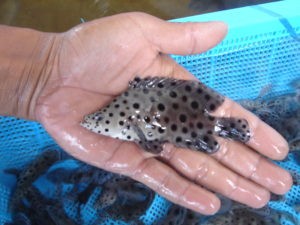BACKGROUND

Humpback grouper (Cromileptes altivelis) fingerling from Palau
Aquatic biosecurity could be described as a system of standardized protocols and measures to deal with biological risks in aquatic environments, such as the risk of diseases, genetic pollution and invasive species. The main aims of aquatic biosecurity are to safeguard human health, the environment, and national economies. Good biosecurity requires a holistic and an extremely proactive approach between nations and territories. The Pacific region, with many comparative advantages regarding fisheries and aquaculture, but at the same time, with highly unique, bio-diverse and sensible aquatic environments, needs to strengthen and further develop aquatic biosecurity standards and guidelines, which will support Pacific Nations to develop their economies in a sustainable and environmentally friendly manner.
Efficient aquatic animal health management and sustainable use and control of introduced aquatic species, both at National and Regional level, require strict border control measures, adequate quarantine protocols to prevent the introduction of animal diseases, plant pests and invasive species, accurate knowledge on pathogens present in the region, suitable pathogen surveillance strategies in order to detect and control disease outbreaks, efficient contingency plans and skilled extension services, among others.
Furthermore, Pacific Island country and territories (PICTs) have an obligation to maintain biosecurity through their commitments to international agreements such as the World Trade Organization Agreement on the Application of Sanitary and Phytosanitary Measures (SPS) and the United Nation’s Convention on Biological Diversity (CBD).
It should be written that the aquaculture sector contributes greatly to improving food and nutrition security and increasing livelihoods within the Pacific region; but most aquatic animals successfully cultured in the region are introduced (e.g., Nile tilapia, common carp, blue shrimp), and new species introductions are being pursued for further aquaculture development. On the other hand, aquatic diseases and pests are a significant threat to the sustainability and productivity of aquaculture in the region. Potential threats for trans-boundary diseases spreading cannot be overlooked.
The geographical isolation of countries, the limited availability of specialist expertise and resources, and narrow prospects for development of specialist capability across multiple disciplines are some of the significant challenges that PICTs face in implementing sustainable aquaculture development and effective aquatic biosecurity governance programmes.
Copyright © 2024. Pacific Community.